and the distribution of digital products.
Understanding BounceBit: A Comprehensive Overview
- BounceBit integrates CeDeFi (Centralized-Enabled Decentralized Finance), combining centralized liquidity with DeFi efficiency to offer institutional-grade yield strategies like funding rate arbitrage and basis trading while ensuring regulated custody for user assets.
- The network operates on a Dual-Token Proof-of-Stake (PoS) model, secured by BB and tokenized BTC (BBTC), allowing Bitcoin to function as an active yield-generating asset while enhancing network security and stability.
- BTC Bridge enables Bitcoin integration, supporting staking, collateralization, and RWA-backed DeFi applications.
- BounceBit Prime bridges RWA and CeDeFi, enabling institutional investors to access yield-bearing real-world assets while leveraging CeDeFi liquidity. Partnerships with Ethena, Ondo Finance, Hashnote, and Google Cloud expand institutional adoption, with the 2025 roadmap prioritizing RWA credit markets, institutional liquidity, and compliance-driven financial products.

Blockchain technology continues to advance, with market participants consistently seeking efficient yield-generation strategies. By the end of 2024, spot and derivative trading volumes on centralized exchanges (CEXs) reaching a yearly record high of $11.3 trillion, according to CCData, highlighting the demand for capital-efficient trading. Institutional players, including market makers and trading desks, leverage structured strategies such as basis trading, perpetual funding arbitrage, and liquidity provisioning to optimize returns. However, access to these opportunities remains limited for retail investors due to capital constraints, infrastructure requirements, and risk management complexities, leaving high-yield strategies largely within the domain of firms with deep liquidity and specialized expertise.
BounceBit was developed to expand access to structured yield-generation strategies by leveraging a hybrid CeFi and DeFi model—CeDeFi. Instead of introducing another staking protocol or speculative yield instrument, BounceBit integrates institutional trading strategies within its ecosystem, providing users with access to returns derived from market-based mechanisms. By utilizing Bitcoin as the foundational asset, BounceBit enables BTC holders to participate in yield-generating activities that are typically accessible only to institutional players.
At its core, BounceBit is a dual-token Layer 1 secured by BTC and its native token, BB, incorporating a CeDeFi infrastructure that enables:
- Institutional-grade yield products based on proven trading strategies.
- Restaking mechanics through novel liquidity custody tokens (LCTs).
- Real World Asset (RWA) integrations to diversify and enhance yield sources.
- Seamless CeDeFi-as-a-Service solutions that connect onchain and off-chain economies.
By bridging the gap between institutional expertise and retail accessibility, BounceBit redefines yield generation in crypto, making sophisticated trading strategies available to all.
Website / X (Twitter) / Discord
BackgroundBounceBit was born out of firsthand exposure to the structural divide in crypto yield opportunities. Founder and CEO Jack Lu, who spent seven years as a partner at NGC Ventures and co-founded Bounce, a decentralized auction house, had deep experience in institutional trading strategies. With a background in quantitative economics and game theory, Lu understood how large trading firms, whales, and mining institutions leveraged sophisticated strategies to generate yield on Bitcoin and stablecoins—while retail investors were locked out due to capital and infrastructure constraints.
"We were meeting a lot of trading teams focused on big whales and mining institutions who had a lot of capital to help them generate interest in Bitcoin or USDT, but this strategy would never be available to retail," Lu recalls. "We saw a good opportunity to gather retail flow and act as big clients to run this strategy."
With this vision in mind, BounceBit was built to bridge institutional-grade yield strategies with retail accessibility, creating a CeDeFi model that combines centralized trading infrastructure with DeFi’s composability. The concept quickly gained traction, securing $6 million in seed funding from lead investors like Breyer Capital, Blockchain Capital, Binance Labs, Boyaa, Nomura, OKX Ventures, HTX Ventures, and Bankless Ventures.
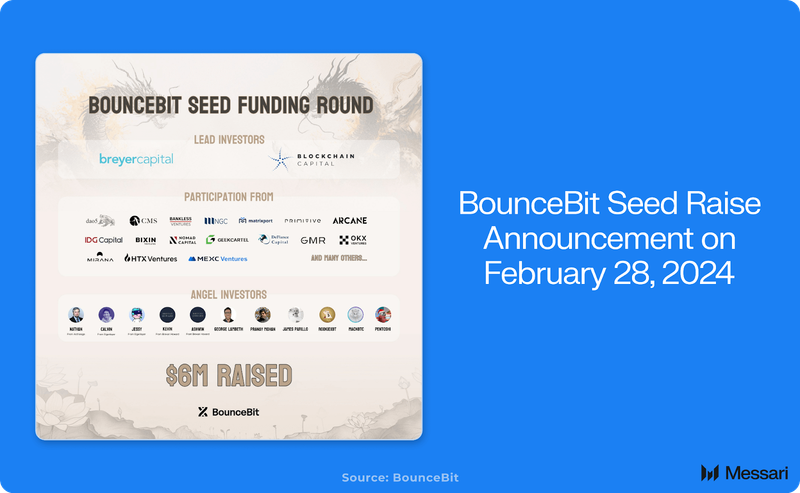 Technology and ProductsWhat is CeDeFi?
Technology and ProductsWhat is CeDeFi?Centralized-Enabled Decentralized Finance (CeDeFi) merges the liquidity depth and trading efficiency of centralized finance (CeFi) with the transparency, composability, and permissionless access of decentralized finance (DeFi). This model addresses a key challenge in the crypto industry: while DeFi provides open financial access, it often lacks the liquidity, execution speed, and institutional-grade security found in CeFi. Conversely, CeFi offers deep markets and capital efficiency but has historically been opaque, requiring users to trust centralized custodians.
CeDeFi provides an alternative where assets are held in regulated, off-exchange custody while still being used for onchain financial activities. BounceBit operates within this CeDeFi paradigm, structuring its ecosystem around Bitcoin yield generation, restaking infrastructure, and institutional-grade trading strategies. Unlike traditional DeFi protocols that primarily rely on lending and staking models, BounceBit employs structured arbitrage and basis trading mechanics to extract yield from market inefficiencies while minimizing exposure to directional price risk.
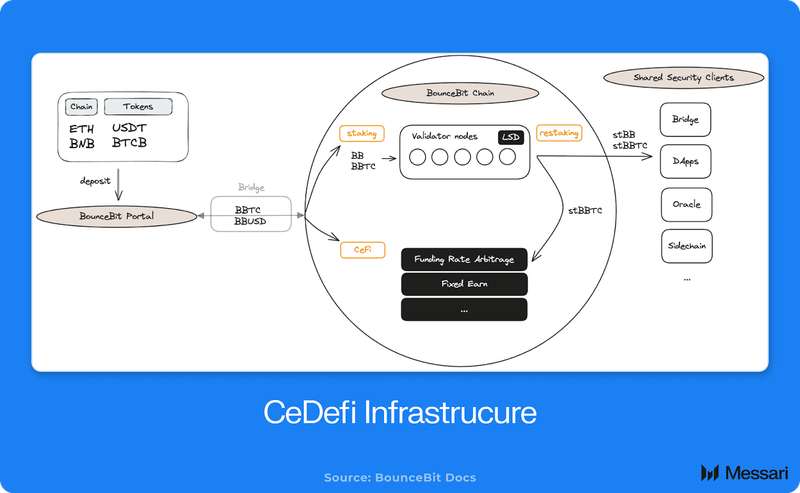 BounceBit’s Core CeDeFi Infrastructure
BounceBit’s Core CeDeFi InfrastructureInstitutional Yield Solutions:
Institutional investors require structured risk management, deep liquidity access, and regulatory compliance when deploying capital into yield-generating products. Unlike retail users, institutions often operate at significantly higher capital volumes, requiring scalable yield strategies that provide consistent returns without overexposure to systemic risk.
BounceBit’s CeDeFi infrastructure is designed to bridge institutional capital with structured trading opportunities, allowing hedge funds, market makers, and proprietary trading firms to execute market-neutral strategies in a controlled environment.
Key to this model is custodial segregation, where assets are held in regulated custody while remaining usable for trading activities. This framework eliminates the single point of failure risk that plagued centralized platforms like FTX, where user deposits were misappropriated due to a lack of verifiable transparency. Instead, BounceBit ensures that funds remain independent of exchange liabilities while still being available for arbitrage trading, lending, and staking.
For institutions, BounceBit offers a combination of:
- Prime Brokerage Access: Enabling institutions to execute arbitrage strategies with minimal slippage through direct liquidity provisioning.
- Cross-Exchange Settlement: Allowing capital to be collateralized across multiple exchanges without requiring on-exchange deposits.
- BTC Restaking: Offering a yield-bearing alternative for institutional Bitcoin holdings by integrating restaking mechanisms that distribute structured returns without requiring active participation in high-risk DeFi strategies.
Liquid Custody Tokens (LCTs)
A fundamental limitation of centralized trading infrastructure is that assets held in custodial accounts are typically restricted to off-chain execution, limiting their utility in decentralized financial applications. BounceBit addresses this issue through Liquid Custody Tokens (LCTs), which allow assets stored in custodial wallets to be mirrored onchain for financial activities while remaining fully redeemable at any time.
LCTs serve as the core mechanism enabling CeDeFi, ensuring that capital can be used for lending, trading, and arbitrage without requiring direct custody transfers. These tokens include:
- BBTC (BounceBit BTC): A 1:1 tokenized representation of Bitcoin, allowing BTC to be used for yield farming, restaking, and collateralized borrowing.
- BBUSD (BounceBit USD): A stablecoin-equivalent token, designed to facilitate onchain settlement, trading strategies, and yield-bearing opportunities.
The core advantages of LCTs include:
- 1:1 Asset Backing: Ensuring that each token maintains full redemption value in custody, eliminating the risk of over-leveraged exposure.
- Seamless OnChain Integration: Allowing institutions to deploy Bitcoin and stablecoin collateral into DeFi without converting to synthetic assets.
- Enhanced Security: Assets remain segregated in institutional-grade custodial accounts, mitigating counterparty risk.
The core advantage of Liquid Custody Tokens (LCTs) lies in their 1:1 asset backing, ensuring that each BBTC and BBUSD token maintains full redemption value in regulated custody, eliminating the risks associated with over-leveraged exposure or fractional reserves. Unlike synthetic assets, LCTs provide seamless onchain integration, allowing institutions to deploy Bitcoin and stablecoin collateral directly into DeFi protocols while retaining the security and verifiability of their holdings. Additionally, these assets remain segregated in institutional-grade custodial accounts, significantly reducing counterparty risk by preventing rehypothecation or unauthorized fund usage.
Funding Rate Arbitrage & Basis Trading
One of the most persistent inefficiencies in crypto markets exists in the pricing of perpetual futures contracts. Unlike traditional futures, perpetual contracts do not have an expiration date, requiring a funding rate mechanism to balance long and short positions. This creates a recurring opportunity for market-neutral trading strategies, which are the foundation of BounceBit’s yield generation.
BounceBit utilizes two primary arbitrage strategies:
Funding rate arbitrage is a strategy that capitalizes on differences in funding fees paid between long and short positions across multiple trading venues. The funding rate is a periodic fee exchanged between long and short traders in perpetual futures markets, designed to keep contract prices aligned with the spot market.
To execute funding rate arbitrage, traders open:
- A long position in the spot market
- A short position in perpetual futures
This structure ensures delta neutrality, eliminating exposure to asset price movements while earning the funding rate yield. For example, if the BTC perpetual futures contract pays a 0.03% funding rate every 8 hours and a trader holds a $2 million position, they can earn $600 per funding period, accumulating an annualized yield of over 32%.
Key Advantages of Funding Rate Arbitrage:
- Market Neutrality: Yields are derived from funding rates, not price speculation.
- Consistent Returns: The strategy remains effective in bull, bear, or sideways markets.
- Institutional Scalability: Large funds can deploy capital into these trades without slippage concerns.
- Basis Trading
Basis trading is another arbitrage mechanism that exploits price differentials between spot and futures markets. Since futures contracts often trade at a premium or discount relative to spot prices, traders can:
- Buy BTC in the spot market while simultaneously selling BTC futures contracts, capturing the spread between the two.
- Hold the position until the contracts converge at expiration, locking in the difference as profit.
- Roll over positions periodically, ensuring yield continuity across different contract settlements.
For example, if the BTC futures contract trades at a 1.5% premium over the spot price, a trader executing a $10 million basis trade can earn $150,000 risk-free when the premium closes.
Key Advantages of Basis Trading:- Non-Directional Profitability: The strategy works regardless of BTC’s price movement.
- Institutional Suitability: Large traders can deploy significant capital without affecting market prices.
- High Liquidity: BTC futures are some of the most liquid instruments in the market, ensuring low execution risk.
Both funding rate arbitrage and basis trading are highly scalable, market-neutral strategies that hedge funds and trading desks have used for years. BounceBit integrates these methods into its CeDeFi ecosystem, allowing users to benefit from these institutional-grade strategies without requiring advanced trading knowledge.
CeDeFi V2: Expanded Yield Strategies & Multi-Asset Support
BounceBit’s CeDeFi V2 (current version) builds on the foundation of V1 by expanding asset support, refining trading strategies, and introducing structured automation as the only BTC-denominated yield provider. While CeDeFi V1 primarily focused on BTC-based arbitrage, the second iteration incorporates ETH, BNB, SOL, and USDT, broadening the scope for institutional and retail participants. This upgrade enhances yield flexibility, risk-adjusted returns, and accessibility across multiple trading environments.
New trading models include Auto, Fixed, and Manual strategies, allowing users to optimize capital deployment based on risk tolerance and preferred management style. Institutions benefit from higher capital efficiency, expanded arbitrage models, and improved security through off-exchange settlement.
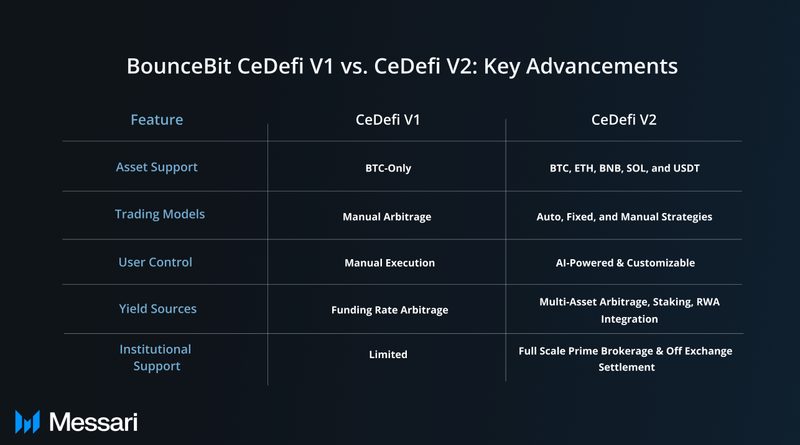 Real World Asset (RWA) & TradFi Integration
Real World Asset (RWA) & TradFi IntegrationThe global RWA market exceeds $500 trillion, yet only a fraction (~$15 billion) has been tokenized. Major institutions—including BlackRock (BUIDL), Franklin Templeton (BENJI), and Hashnote (USYC)—have brought RWAs onchain, but these assets remain largely underutilized in structured crypto yield strategies.
BounceBit addresses this gap by:
- Providing institutional-grade settlement layers for RWA-backed trading strategies.
- Integrating tokenized assets with centralized and decentralized liquidity markets.
- Developing onchain credit markets for capital-efficient deployment.
Integrating Real World Assets (RWAs) into CeDeFi is a necessary evolution in bridging traditional finance with blockchain-based financial infrastructure. While CeDeFi connects centralized exchange liquidity with DeFi efficiency, its long-term sustainability depends on incorporating yield-bearing instruments beyond crypto-native strategies. Traditional finance holds trillions in U.S. Treasuries, corporate bonds, money market funds, and commodities, yet these assets remain largely inaccessible within crypto ecosystems. BounceBit transforms RWAs into productive collateral, enabling both institutional and retail investors to generate structured yield while maintaining liquidity and capital efficiency.
Most existing RWA solutions focus on tokenization without providing significant trading or lending utility, leaving them underutilized. BounceBit differs in that it integrates RWAs directly into its structured yield generation strategies. Through a regulated custody framework, tokenized RWAs are mirrored into CeDeFi, allowing them to earn base yield from their underlying assets while being actively deployed in trading, lending, and funding rate arbitrage strategies. This dual-yield approach allows capital to accrue returns from traditional financial instruments while participating in CeDeFi trading strategies without the need for liquidation.
By merging regulated financial infrastructure with onchain yield generation, BounceBit enhances capital efficiency and ensures RWAs function as more than passive assets. This model allows for seamless interoperability between traditional finance and CeDeFi, making structured yield generation scalable and accessible across both institutional and decentralized markets.
BounceBit Chain: Dual-Token PoS & BTC Restaking InfrastructureBounceBit Chain is a Layer 1 blockchain that integrates Bitcoin’s liquidity with Ethereum’s smart contract functionality. As an EVM-compatible network, BounceBit enables the seamless deployment of Ethereum-based smart contracts, allowing developers to migrate projects without modifying their existing Solidity code. This compatibility ensures access to Ethereum’s well-established tooling ecosystem, providing developers with a secure and scalable foundation for building decentralized applications. Additionally, BounceBit plans to incorporate Parallel VM and Account Abstraction, improving transaction efficiency and expanding the capabilities of smart contracts deployed on its network.
Since Bitcoin cannot natively interact with smart contracts, BounceBit introduces the BTC Bridge to integrate BTC into its ecosystem. The bridge allows users to deposit Bitcoin into a regulated custody framework, receiving BBTC—a 1:1 tokenized representation of BTC—on BounceBit’s network. This wrapped version of BTC enables participation in staking, lending, and liquidity provisioning while maintaining its backing by the original Bitcoin reserves. The BTC Bridge ensures that Bitcoin holders can engage with BounceBit’s DeFi infrastructure without relinquishing custody of their assets.
To enhance network security, BounceBit employs a Dual-Token Proof-of-Stake (PoS) consensus model, utilizing both BB (the native asset) and BBTC (tokenized BTC). Unlike traditional single-token staking models, this structure diversifies the security framework by incorporating Bitcoin’s liquidity alongside BounceBit’s ecosystem token. Validators are selected through an epoch-based process, considering the combined value of BB and BBTC staked. This system reduces the volatility risks associated with newer Layer 1 tokens by leveraging Bitcoin’s relative price stability and deeper liquidity.
Participants can stake BB and BBTC to become validators or delegate their tokens to existing validators. Staking rewards are distributed based on participation, with validators earning transaction fees and incentives for securing the network. The consensus model also introduces restaking, enabling BBBTC and BB holders to allocate their staked assets to Shared Security Clients (SSCs)—such as oracles, sidechains, and cross-chain bridges—enhancing security for additional blockchain infrastructure.
The staking framework incorporates validator incentives and penalties to maintain economic sustainability and network integrity. Validators can charge a commission on staking rewards, ensuring long-term viability, while governance mechanisms enforce slashing penalties for malicious behavior or performance failures. Additionally, staking participants must consider validator selection carefully, as performance metrics and commission rates directly impact rewards earned over time.
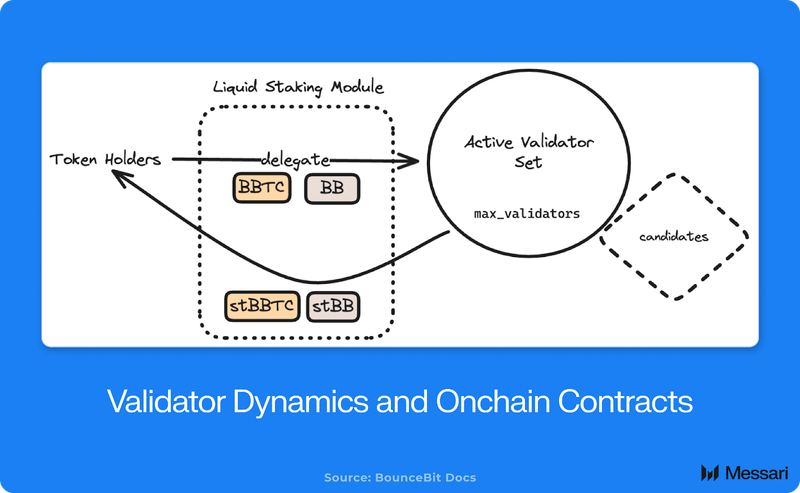 BounceClub
BounceClubBounceClub serves as the ecosystem layer of BounceBit operating as a dApp, integrating DeFi infrastructure with advanced trading tools and community-driven features. It extends BounceBit’s CeDeFi framework by offering derivatives trading, meme token launches, and AI-driven automation, creating a dynamic environment where users can access structured trading strategies and new financial products. By merging traditional DeFi primitives with specialized trading solutions, BounceClub enhances capital efficiency within the BounceBit ecosystem.
One of BounceClub’s standout innovations is Quanto Trading, a derivatives market enabling cross-asset perpetual contracts. Users can open stock and index-based trading positions while posting BB or other assets as collateral, allowing for greater capital flexibility and risk diversification. Additionally, the Meme Token Launchpad facilitates community-driven token launches with structured liquidity mechanisms, utilizing bonding curves to ensure fair price discovery and sustainable ecosystem participation. AI-powered DeFAI Agents introduce automation into trading strategies, allowing users to customize trading logic and optimize yield based on predefined parameters. This interconnected ecosystem provides a comprehensive CeDeFi experience, blending retail accessibility with institutional-grade trading mechanics.
TokenomicsThe BB token is the foundation of BounceBit’s economic model, facilitating network security, governance, transaction execution, and liquidity incentives. With a fixed supply of 2.1 billion BB, its design mirrors Bitcoin’s 21 million supply but is scaled to meet the needs of an active Layer 1 blockchain.
BB plays a pivotal role across the ecosystem:
- Network Security: Staked BB secures the network via BounceBit’s PoS model.
- Transaction Fees: Used to pay gas fees for transactions and smart contracts.
- Governance: Enables holders to vote on protocol upgrades and ecosystem decisions.
- Ecosystem Utility: Integrated into DeFi applications, meme token launches, and trading products within BounceClub.
- Cross-Chain Liquidity: Utilized in multi-chain liquidity mechanisms, ensuring BB’s presence across Ethereum, BNB Chain, and beyond.
BB Token Distribution & Vesting Schedule
To maintain a healthy supply-demand balance and align incentives across different stakeholders, BB follows a structured vesting and distribution model:
- Total Supply: 2.1 billion BB (fixed, no inflation)
- Staking Rewards & Delegation Program: 35% (distributed over 10 years)
- Investor Allocation: 21%, 12-month lock-up, then 5% unlocked monthly
- Team Allocation: 10%, 12-month lock-up, then 2.5% unlocked monthly
- Advisors: 5%, 12-month lock-up, then 2.5% unlocked monthly
- BounceClub & Ecosystem Reserve: 14%, 4.5% unlocked at TGE, then 12-month lock, followed by 6.5% monthly unlock for 6 months, then 2.5% monthly unlock
- Binance Megadrop: 8%, fully unlocked at TGE
- Market Making: 3%, fully unlocked at TGE
- Testnet & TVL Incentives: 4%, fully unlocked at TGE
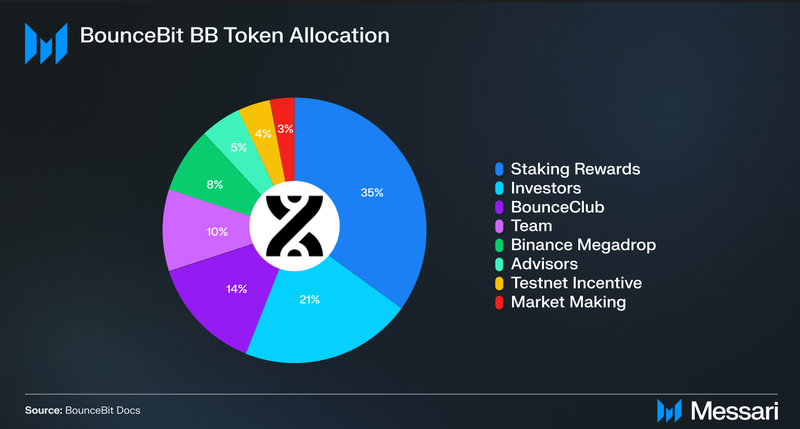 Partnerships and Integrations
Partnerships and IntegrationsBounceBit has strategically partnered with several organizations to enhance its CeDeFi infrastructure and expand access to real-world assets (RWAs). These collaborations aim to bridge traditional finance with decentralized finance, offering users diversified and institutional-grade financial products.
- Ethena Partnership: Through a collaboration with Ethena, BounceBit offers users access to high-yield DeFi products. Participants can stake BBUSD on the BounceBit Chain to earn sUSDE yield, ENA rewards, BB rewards, and additional sats per day as part of Ethena’s Sats Campaign. Rewards accumulate in cycles, and unstaking requires a seven-day waiting period, followed by another seven days for completion.
- Boyaa Partnership: Boyaa Interactive, Asia's largest corporate Bitcoin holder, has strategically invested in BounceBit by acquiring BB on the open market and staking some of its BTC holdings within BounceBit’s CeDeFi strategies. This collaboration strengthens the platform’s institutional credibility and expands its BTC-denominated yield offerings.
- Ondo Finance & USDY Integration: The introduction of USDY, a tokenized real-world asset issued by Ondo Finance, strengthens BounceBit’s CeDeFi ecosystem by providing access to institutional-grade yield products. USDY is backed by U.S. Treasuries, offering a stable yield source for users. This integration includes a dedicated USDY vault designed for optimized returns, enabling seamless access to on-chain yield opportunities while maintaining exposure to traditional financial instruments.
- Hashnote Partnership (Now Acquired by Circle): BounceBit has integrated US Yield Coin (USYC), a tokenized version of Hashnote’s International Short Duration Yield Fund. Backed by U.S. government securities, USYC offers a transparent, institutional-grade yield mechanism within the BounceBit ecosystem. This partnership expands the accessibility of tokenized RWAs, bridging regulated financial products with decentralized finance.
- DigiFT Collaboration: A partnership with DigiFT brings institutional-grade real-world assets into the BounceBit ecosystem. The integration provides users with access to investment products like uMINT, a tokenized money market fund issued under UBS Asset Management. Benefits include diversification into sustainable yield assets, real-time redemption capabilities, and non-custodial solutions for greater security.
- Plume Integration: Plume, a modular L2 blockchain built for RWAs, is now part of BounceBit’s network. The integration enables access to tokenized assets while leveraging Plume’s compliance and settlement framework. Institutional and retail participants benefit from expanded CeDeFi capabilities.
- Google Cloud Partnership: A collaboration with Google Cloud supports the development of infrastructure for institutional-grade real-world asset integration. The partnership aims to improve scalability, optimize asset tokenization, and facilitate onboarding processes, particularly in Southeast Asia.
- LayerZero Integration: With LayerZero’s omnichain messaging protocol integrated, cross-chain interactions for Bitcoin re-pledging are now possible. The integration enhances interoperability, allowing seamless asset transfers across multiple networks.
Building on the momentum of 2024, BounceBit's 2025 roadmap marks a strategic shift towards dollar-denominated yield products as market conditions evolve. While 2024 focused on BTC-denominated yield strategies, the new approach reflects a maturing market where institutions increasingly seek stable, capital-efficient yield opportunities tied to fiat-backed assets. This "all-weather strategy" optimizes risk-adjusted returns across varying market conditions, ensuring sustainable yield generation regardless of volatility.
The roadmap prioritizes strengthening CeDeFi infrastructure, integrating real-world assets (RWAs), and expanding institutional partnerships. By refining dollar-denominated products and establishing a scalable RWA settlement and clearing framework, BounceBit aims to bridge the gap between traditional finance and decentralized finance.
- Q1 2025 – Launch of BounceBit Prime & Institutional Expansion
BounceBit Prime, a flagship institutional platform, will be introduced to bridge CeDeFi with traditional finance (TradFi) investment strategies. It enables institutional investors to engage with yield-bearing RWAs while leveraging Asia’s liquidity infrastructure. The platform facilitates capital-efficient strategies for both digital asset firms and TradFi investors.
Additionally, CeDeFi Liquidity Mining (CLM) will be deployed in partnership with centralized exchanges (CEXs). CLM incentivizes on-chain trading activity with token-based rewards, linking exchange liquidity with decentralized financial mechanisms.
- Q2 2025 – BB Chain Ecosystem Development & RWA Credit Market
The second quarter will focus on expanding BounceBit Chain’s (BB Chain) infrastructure, establishing a foundation for RWA-based credit markets.
The RWA Credit Market will introduce tokenized real-world assets as collateral in CeDeFi applications. This expansion allows institutions and users to leverage assets such as tokenized Treasuries and private credit instruments to generate additional yield or obtain financing.
BB Chain will also support CeDeFi-native applications, enabling new protocols to integrate BounceBit’s yield-generating mechanisms. Institutional market makers and liquidity providers will further enhance capital efficiency across the network.
- Q3 2025 – RWA Settlement & Clearing House
A Settlement and Clearing House will be deployed to facilitate efficient and transparent transactions of RWAs within CeDeFi. This framework introduces standardized processes for tokenized asset issuance, redemption, and secondary market trading, improving liquidity and price stability.
The quarter will also see the launch of fungible and interoperable tokenized assets, allowing for seamless swaps and collateralization across different RWA-backed instruments. This expansion improves capital movement between on-chain and off-chain financial structures.
- Q4 2025 – Regulatory Compliance & Institutional Product Expansion
The final quarter of 2025 will introduce regulatory-compliant yield products, ensuring adherence to evolving global financial standards. These products will cater to institutional investors requiring regulated exposure to tokenized assets and yield strategies.
Closing SummaryBounceBit integrates CeFi and DeFi through its CeDeFi model, enabling institutional-grade yield strategies, Bitcoin restaking, and real-world asset (RWA) integrations. Its Dual-Token Proof-of-Stake (PoS) model, secured by BB and tokenized BTC (BBTC), enhances network security while expanding Bitcoin’s role beyond passive storage. The BTC Bridge facilitates seamless Bitcoin integration into the ecosystem, allowing BTC to be staked, collateralized, and utilized within DeFi applications. BounceClub further extends BounceBit’s ecosystem, incorporating derivatives trading, structured DeFi strategies, and AI-driven automation.
With 2.1 billion BB tokens, BounceBit’s tokenomics model supports long-term network sustainability through staking rewards, governance incentives, and liquidity provisioning. Strategic partnerships with Ethena, Ondo Finance, Hashnote, Plume, and Google Cloud strengthen its integration with traditional finance and institutional markets. The 2025 roadmap focuses on enhancing CeDeFi liquidity, RWA-based credit markets, and institutional-grade settlement solutions, positioning BounceBit as a key player in bridging traditional finance and decentralized finance.
- Home
- About Us
- Write For Us / Submit Content
- Advertising And Affiliates
- Feeds And Syndication
- Contact Us
- Login
- Privacy
All Rights Reserved. Copyright 2025, Central Coast Communications, Inc.